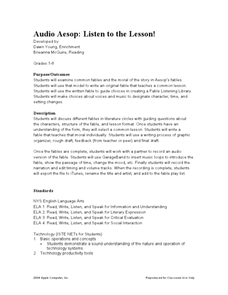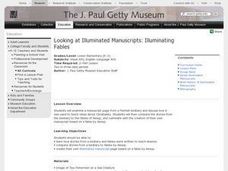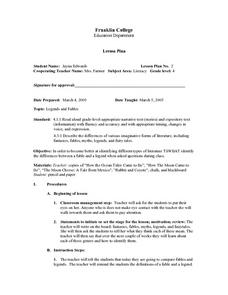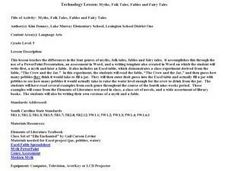Curated OER
Audio Aesop: Listen to the Lesson!
Aesop's Fables are the focus of this language arts instructional activity. Young philosophers study and discuss the morals found in the most famous of Aesop's Fables. They write an original fable that teaches a common moral. A "Fable...
Curated OER
How to Make Plurals of Words That End In "f" or "fe": A "F"able
Identify nouns that end in "f" or "fe." Review how to make words plural and the specific rules for words that end in "f" or "fe." Complete the fable activity sheet and find and write the plurals for words they find that end in "f" or...
Core Knowledge Foundation
First Grade Skills Unit 3
Four weeks, 19 lessons—this unit covers five new vowel spelling patterns, tricky words, spellings, verb tenses, reading fables and exploring the writing process. Lessons offer review, an introduction to the concept, skills practice,...
Curated OER
Which Story Matches the Given Theme?
Model for young learners how to determine the theme of a story. Read aloud Aesop’s The Fox and the Stork. Chart the plot and the main idea of the fable, showing class members how these elements support the theme. Fable titles for...
Curated OER
Acting Like a Bunch of Animals: Fables and Human
The video "The Tales of Aesop" traces for viewers the history of fables and identifies their characteristics. The class then goes to the web site "The Fisherman and the Little Fish" where they examine the classic and a modern version of...
Curated OER
Fables and Trickster Tales Around the World
Students analyze fables and trickster tales from various cultural traditions. In this fable analysis lesson plan, students identify the elements of fables and trickster stories. Students read Aesop's fables and Ananse spider...
Curated OER
Fables Unit Lesson Plan
Students study fables in a broad context. In this literary lesson on fables, students define terms unique to them. Students use a variety of technological resources to gather and classify information into three categories. Students also...
Scholastic
Folk and Fairy Tale Readers: The Tortoise and the Hare
Slow and steady wins the race to fluent reading with this printable version of "The Tortoise and the Hare". Presenting children with fun illustrations and a repetitive story structure, this resource is perfect for developing...
Curated OER
Writing a Fable
Students are introduced to the definition of a fable in that it is a story that has a moral for people to apply in their lives. They then read a fable together so they have a better understanding. Next, students write their own fables.
Curated OER
Kindness Fables
Young scholars create a fable that is based on kindness. In this fables lesson plan, students read and discuss different fables. Then they discuss kindness, and write their own fables based on the kindness of others.
Curated OER
Greek culture and Aesop's Fables
Tenth graders explain political and social thought during the Greek 6th and 5th centuries B.C. They research five to eight fables, figuring out the moral for each and writing an essay on how Aesop influenced the morals and ideals of...
Curated OER
Understanding and Writing Fables
Third graders review with the teacher the characteristics for a fable and what it is. They read one paragraph each from the story, "The Fox and the Stork" aloud. They then answer comprehension questions aloud. Next, they listen to four...
Curated OER
Looking at Illuminated Manuscripts: Illuminating Fables
Students examine a page from a Flemish bestiary. They compare the stories from the bestiary to the fables of Aesop, and culminate with the creation of their own manuscript based on a fable by Aesop.
Curated OER
Fantasy, Fables, Myths, Legends & Fairy Tales
Students identify the differences between fantasies, fables, myths, legends and fairy tales. In groups, they create their own versions of the different genres. They practice identifying the examples, as well.
Curated OER
Legends and Fables
Fourth graders identify and discuss the differences between legends and fables. They define fable and legend, then as a class take turns reading our books. Students select two of the stories, and complete a Venn diagram, comparing one...
Curated OER
Fable Writing
Students listen to and discuss various fables, and identify the moral and central themes. They write their own personal fables and create illustrations to go with them.
Curated OER
Fable Writing--Inter-disciplinary Approach To Social Sciences
Students recognize the elements of a fable and write an original fable. They make connections with morals and other law-related concepts.
Curated OER
June 4, 620 BC - Aesop's Fables
In this writing prompt worksheet, students learn that June 4, 620 BC was the birthday of Greek born Aesop of Aesop's fables. Students use resources in the classroom to research the fables and then write a fable of their own.
Curated OER
Is That a Fact? A Comment on Modern Fables
Students complete literary analysis for modern fables or urban legends. In this modern fables lesson, students listen to an urban legend and discuss it. Students then research urban legends online and write their own urban legend.
Curated OER
Secret Stories: Exploring the Elements of Folktales and Fables
Students are introduced to the characteristics of fables and folktales. In groups, they read and identify the various elements in the stories they read from around the world. For each story, they analyze the setting and the various...
Curated OER
Fearless Fables: The Sheep And the Pig
In this reading comprehension worksheet, students participate in reading a fable about some animals who are building a home of their own. This fable has a clear moral presented. There are no questions on the page.
Curated OER
Fearless Fables: The Lion And the Mouse
In this reading comprehension worksheet, students participate in reading a classic fable about a lion and a mouse. There are no questions on the page.
Curated OER
Myths, Folk Tales, Fables and Fairy Tales
Fifth graders study the differences in the four genres of myths, folk tales, fables and fairy tales. They use a PowerPoint Presentation, an assessment in Word, and a writing template also created in Word on which they write first, a...
Curated OER
Lots of Lessons from Aesop
Aesop’s Fables offer young learners an opportunity to study figurative language. After reviewing theme, simile, alliteration, and metaphor, model for your pupils how to identify examples of these devices in the fable. Class members then...
Other popular searches
- Writing Fables
- Morals Fables
- Aesop's Fables
- Characteristics of Fables
- Fables and Fairy Tales
- Aesops Fables
- Myths Fables
- Aesop Fables
- Lesson Plans on Fables
- Fable Story Elements
- Compare Contrast Myth Fable
- Reader's Theater Fable

























